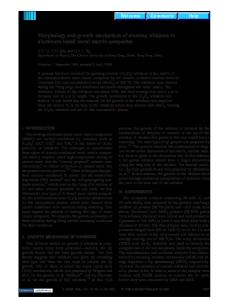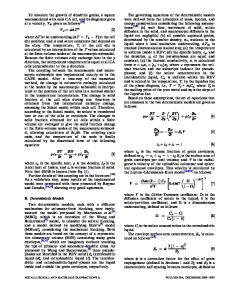Models of displacement and blocking force of ionic-polymer metal composites based on actuation mechanism
- PDF / 993,832 Bytes
- 7 Pages / 595.276 x 790.866 pts Page_size
- 20 Downloads / 313 Views
Models of displacement and blocking force of ionic‑polymer metal composites based on actuation mechanism Liang Yang1 · Dongsheng Zhang1 · Xining Zhang1 · Aifei Tian2 · Xixi Wang2 Received: 16 February 2020 / Accepted: 13 April 2020 © Springer-Verlag GmbH Germany, part of Springer Nature 2020
Abstract In this study, starting from the mechanism of ionic-polymer metal composites (IPMC) blocking force and displacement, the steady state of IPMC with maximum driving force is analyzed, and the mathematical model of displacement and blocking force of IPMC is established. The displacement and blocking force of Pt-IPMC are measured, and the proposed mathematical model is verified. The results show that with the increase in voltage, IPMC shows the tendency of increasing first and then decreasing. It is concluded that there is a nonlinear quartic polynomial relationship from microforce analysis between voltage and displacement, voltage and force, and the relative error verified by experiments is less than 10%. The theoretical model proposed in the paper can well reflect the relationship between voltage and displacement, and force, which provides a basis for the further application and theoretical basic modeling of IPMC. Keywords Ionic-polymer metal composite · IPMC · Blocking force · Displacement
1 Introduction Ionic-polymer metal composites (IPMCs) represent a class of electroactive polymers (EAPs) and have built-in actuation and sensing capabilities [1, 2]. Basically, IPMCs can convert mechanical energy into electrical energy and vice versa [3]. In the past two decades, they have received significant interest because of their inherent polarity, high sensitivity, large deflection, and ability to work in wet and dry environments, as well as bio-compatible and amenable to microfabrication [4]. Due to these qualities, the materials have been intensively researched for the medical field, biomimetic, and micromechanic [5, 6]. For example, a jellyfish-like underwater microrobot [7], an active fin [8], active catheter-guidewire maneuvering [9], refreshable braille display [10], and drug-release device [11].
* Liang Yang [email protected] * Dongsheng Zhang [email protected] 1
School of Mechanical Engineering, Xi’an Jiaotong University, Xi’an 710049, China
School of Materials Science and Engineering, Xi’an University of Science and Technology, Xi’an 710054, China
2
Recent studies on characterization and modeling of IPMC could be found in literatures [12–19]. Maurizio Porfiri [12] presented a mixture theory framework for mechanical modeling of IPMCs and of species interactions occurring therein, and developed a physics-based model for the sensing and actuation of IPMCs undergoing small deformations. An empirical modeling approach was adopted, in which a transfer function with temperature-dependent coefficients was used to represent the sensing dynamics [13]. The motion of an IPMC cantilever under a periodic voltage control was modeled [14]. An estimation of the power harvested by the cantilever IPMC beam from the ba
Data Loading...











